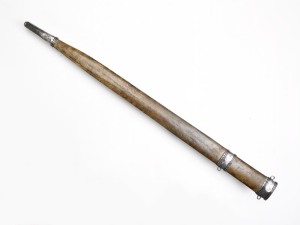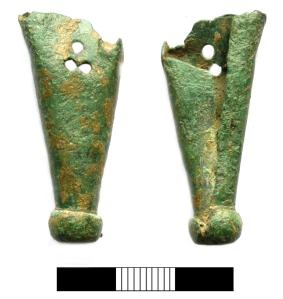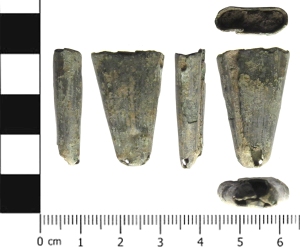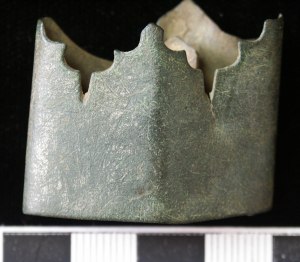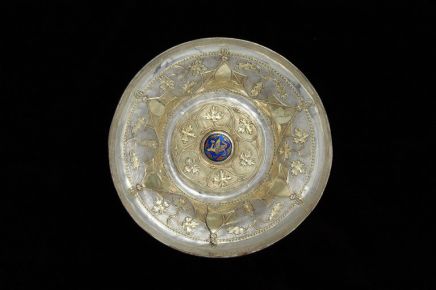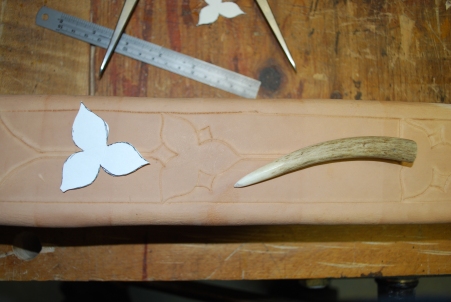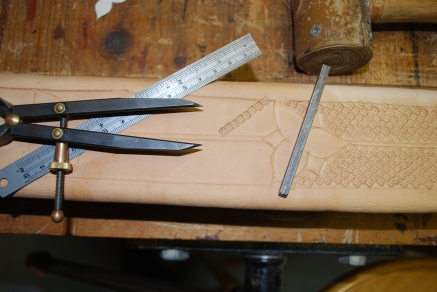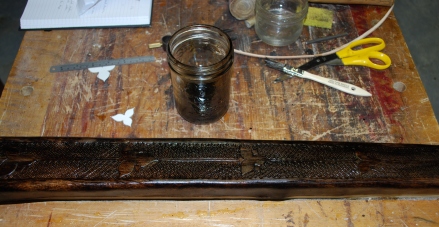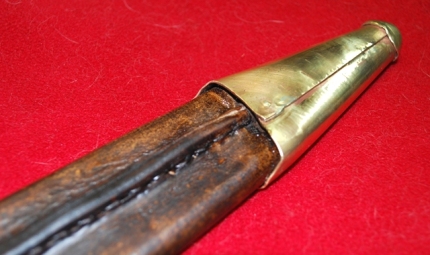I decided to make a new scabbard for Ealdormere’s Sword of State. The sword is an early 15th century style great sword with brass cross guard and pommel and a walnut hilt. As regalia, the scabbard will need to function both as protection for the sword blade and must have a decorative aspect fitting to its status. It will also need to be capable of withstanding the day-to-day damage of being handled in rough circumstances and climatic changes.
Period Scabbard Design:
References A-D (at the end of this post) were reviewed for construction of sword scabbards through the medieval period. In particular, the collection from the Museum of London (MoL, Ref. C) was searched for sword scabbards from 1300 to 1500. Most of the artefacts did not have a wood core, although it is unknown if it had rotted away. A review of the dimensions of the scabbards did not reveal a pattern, i.e. that known wood cored scabbards were wider than non-wood. In the case of the Westminster Bridge sword, both the blade and the silver mounts are extant. Unfortunately, the dimensions provided for the mounts are overall dimensions, and it is unclear if they include the side suspension rings.
The Museum of London database does not provide the thickness of the leather, only the overall dimensions. Artefact A26703 has a clear separation between the leather and the wooden core and was used to estimate the thickness of the leather.
Based on the dimensions provided, the photo was scaled to estimate a leather thickness of 2mm, or around 5oz. Returning to the Westminster Bridge sword, assuming the dimensions provided do not include the suspension rings, and assuming 5oz leather, a wooden core would have a thickness of no more than 3mm. This does not take into consideration “slop” in the fit, nor the losses due to corrosion from the dimensions of the iron blade.
The Portable Antiquities Scheme (PAS, Ref. D) was searched for chapes from the period 1300-1500. The vast majority in the database were of copper-alloy; 672 vice 12 for silver. These were fairly evenly divided between cast and sheet construction. Sheet chapes were folded around the scabbard and soldered together; some had a knop added to the tip as either decoration or reinforcement of the folded tip. Examples of this form are provided below. The top mount on the mouth of the scabbard was made in a similar fashion. The silver mounts from the Westminster Bridge sword appear to share this construction method.
Manufacture and Design Decisions:
As this item will be subject to a high degree of wear and tear, I chose to use leather only for the scabbard. I was concerned that a wooden core, particularly of this length, could get broken and repair would be impossible. I used 6-7 oz vegetable tanned leather for rigidity while still being easily formed around the tight curves of the blade edge.
Originally, I didn’t have the actual sword so I used a hardboard model made from a tracing. I began the work with this, but as I needed a good fit and was concerned it would be too loose, or worse too tight, I arranged to borrow the sword. Unfortunately, that only left me with one week to finish the job.
For a design, I modified the stamped and impressed decoration on MoL artefact A3678.
The main element is a fleur-de-lis, which I have replaced with repeated trefoils based on a 14th century silver bowl in the Victoria and Albert museum. The trefoil is formed within an equilateral triangle, the proportions were developed through geometry and the negative space triangles in the petals were flipped over to create the leaves of a trillium.
I used 6 trefoils to represent the five Baronies, plus one for the Shires. The design was scaled to fit the scabbard, two patterns were cut from cardstock, inscribed using a pointed antler tool and impressed, rather than cut, into the leather. The ground work is a stamp of four pellets in a diamond pattern repeated on an approximately 45° angle, as per the MoL artefact. I used dividers to layout the angle, scribed a line just above each trefoil, and worked up and down from there. The stamp was made from a piece of 3/16” steel, similar to period examples.
I treated the leather with a solution of alum and distilled water to act as a mordant. The dye is made from black walnut husks soaked in ammonia. I chose brown rather than black to mirror the walnut hilt of the sword.
A review of the MoL scabbards shows that most were sewn up the back face using a flesh-grain seam, rather than edge-grain which would lie flat but would not be as strong. I used an edge-grain seam in a harness stitch under the mounts, so that they would sit flat. However, I used flesh-grain harness stitching for the exposed portion of the seam for added strength. As the seam was sewn, I worked the fold line with an antler tool to draw the seam tight. After sewing, I trimmed the excess leather from the seam, rounded the corners, burnished it lightly with a bone tool, then re-dyed the exposed leather. The scabbard was left overnight to dry, then heated lightly and treated with a modern water-repellent conditioner. I wrapped the steel sword blade in tape to prevent it from rusting.
I patterned the chape using annealed brass foil. I then made the top mount and chape from 20 gauge brass sheet, chosen to mirror the brass guard and pommel of the sword. I left them undecorated to contrast with the highly decorated leather. After the chape was folded to shape, I dagged and folded the tip, as shown in the bottom right corner of PAS artefact SWYOR-F55853 (above). I used a dapping block to create a brass cap, unfortunately of a slightly different brass alloy, giving a different colour to the cap. I then put both the chape and the cap back in the dapping block to ensure a good fit for soldering. The pieces were assembled with binding wire and the seams soldered using modern silver solder. I had difficulty maintaining a good fit in the folded portion of the chape, which resulted in a poor solder join. I reinforced the overlap with a single rivet at the top, a feature seen on some of the chapes in the PAS collection. I then trimmed and hammered the edges of the cap flush to the chape. Finally, I polished everything with fine sandpaper and oil. I fastened the chape to the leather with a single copper rivet at the top. I made the top mount in a similar fashion.
Lessons Learned:
- When I began the project I did not have the sword, only a tracing. I made a mock-up of the blade using 1/8” hardboard but was concerned that the fit would be too sloppy. A test of the fit with the sword confirmed my suspicions. Fortunately, Their Majesties were willing to allow me to borrow the sword for a proper fitting. The fact that the leather had already been formed slightly oversized made the sewing awkward as I had to reshape the leather for each section of stitching. It also meant that the decoration was too wide; I had intended for there to be a thin blank border.
- The chape: I should have riveted the overlap first, then soldered it together. The rivets would have held the seam tight enough for the solder to flow properly. I also should have paid better attention when grabbing a piece of scrap for the tip cap so that it was of the same sheet as the rest of the chape and the colour would match.
- Lesson to come: just how well a period leather dye stands up to general wear and tear…
References:
- “Knives and Scabbards (Medieval Finds from Excavations in London)” : ISBN-10: 1843833530
- “Craft, Industry and Everyday Life: Leather and Leatherworking in Anglo-Scandinavian and Medieval York (The Small Finds)” : ISBN-10: 1902771362.
- Museum of London (MoL): http://collections.museumoflondon.org.uk/online
- Portable Antiquities Scheme (PAS): http://finds.org.uk
- Victoria and Albert Museum (V&A): http://collections.vam.ac.uk/

